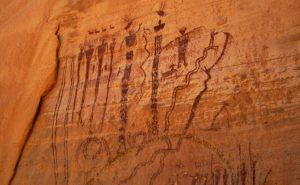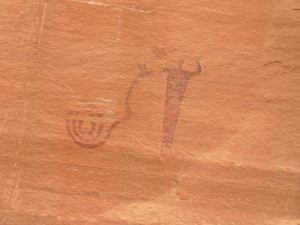Horseshoe Canyon in Utah is home to the Buckhorn Wash Pictograph Panel. The Buckhorn Wash Pictograph Panel is part of a hundred and thirty-foot collection of large anthropomorphic pictographs designs. These designs attributed to the Archaic Period are most likely to have been created by a hunter gather group referred to as the “Barrier Canyon people.” Although the Barrier Canyon people did not live there year round as they were nomadic, it is likely that they would pass through Horseshoe Canyon seasonally.
This then likely explains the purpose behind the pictographs; the canyons have very difficult terrain even to this day (visitor sites detail the canyon as inaccessible for wheelchairs and challenging for inexperienced hikers) and hence the designs were likely used as some sort of religious ceremony for safe travel. This is further evidenced by the location of the pictographs. The pictographs are not located within caverns or places of likely temporary habitation, but rather they are in very visible locations. Most of the designs are near the entrances and exits of long canyons. This indicates that the pictographs were likely painted before entering a long stretch of canyon, in order to pray to some sort of religious figure for safety, and were painted after having exited a stretch of cavern as means of thanks for a safe journey. There also seems to be evidence of respect for these drawings as despite the fact that there is a copious number, very few have been painted over, which gives additional merit to the idea that these designs had religious implications.
The religious implications of the designs are also evidenced by the classification that archeologists have done to the different pictographs to divide them into figures known as composite, citizen, and spirit. These then show that the Barrier Canyon people were trying to indicate or initiate contact between themselves and some sort of gods. The citizen figures are discernibly humanoid and shorter than the composite or the spirit figures and were typically using their arms in legs in some sort of activity such as running. In contrast, the composite figures did have some human-like body parts but also were made up of animals. The most common animals used were snakes, sheep, and birds, which gives some indication as to the majority of animals that lived in the canyons. Finally, the spirit figures are arguably the most interesting as they give further evidence for the notion that these drawings were religious in nature. They were anthropomorphic, however, they were also frequently missing limbs and had some other notable inhuman characteristic (large eyes, horns, or antennae). Notably, their torsos were often marked with symbols that represented the elements. This provides strong indication that these pictographs were used as a sort of religious ritual to both secure safe passage and show gratitude for it.
For further reading:
- http://arthistoryworlds.org/barrier-canyon/
- http://www.smithsonianmag.com/arts-culture/traces-of-a-lost-people-84026156/
- https://www.nps.gov/cany/learn/historyculture/horseshoehistory.htm
Sources:
- http://www.bcsproject.org/barrierstyle.html
- http://www.sanrafaelcountry.com/san-rafael-swell-buckhorn-wash-rock-art-panel.html
- http://climb-utah.com/SRS/buckhorn.htm
Images:



Pictographs and petroglyphs are often still considered important for Native Americans living in the four corners region. Rock art sites are found all through out this region, have archaeologist able to match any of the depictions to other sites?
Check out the painted rock petroglyph site in Arizona